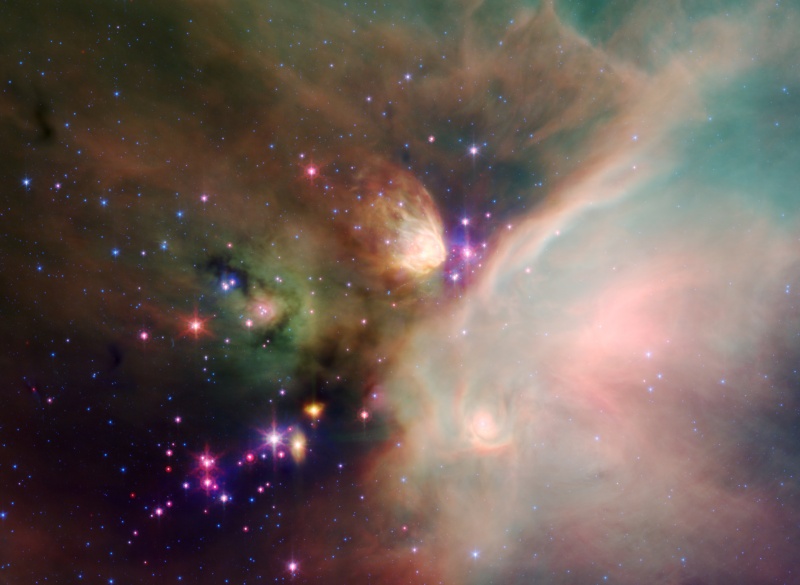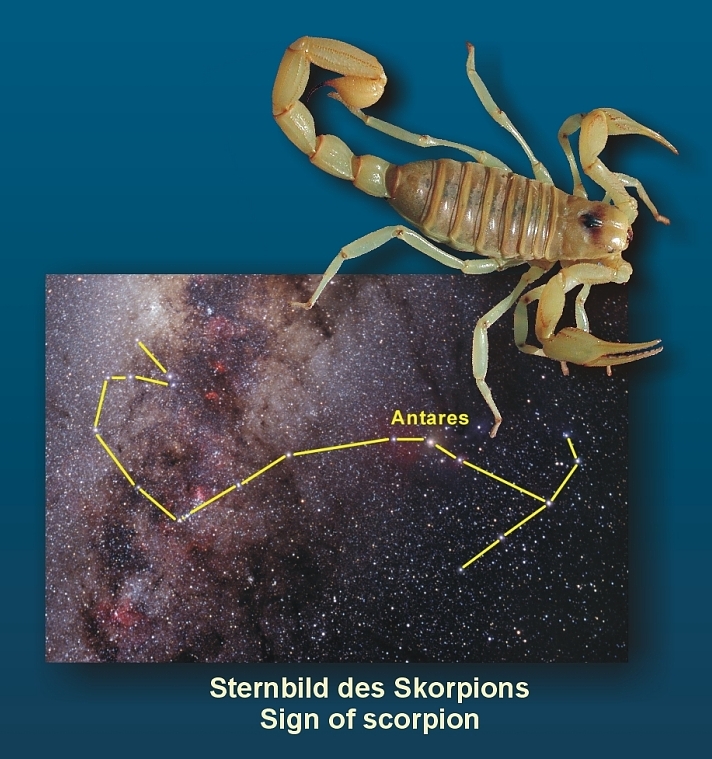Talk about iridecencies! (APOD 15 Feb 2008)
Posted: Fri Feb 15, 2008 6:12 pm
Rho Ophiuchi (oh'-fee-yu-kee)
http://apod.nasa.gov/apod/ap080215.html

<<Why is the sky near Antares and Rho Ophiuchi so colorful? The colors result from a mixture of objects and processes. Fine dust illuminated from the front by starlight produces blue reflection nebulae. Gaseous clouds whose atoms are excited by ultraviolet starlight produce reddish emission nebulae. Backlit dust clouds block starlight and so appear dark. Antares, a red supergiant and one of the brighter stars in the night sky, lights up the yellow-red clouds on the upper left. Rho Ophiuchi lies at the center of the blue nebula on the right. The distant globular cluster M4 is visible just below Antares, and to the left of the red cloud engulfing Sigma Scorpii. These star clouds are even more colorful than humans can see, emitting light across the electromagnetic spectrum.>>
http://antwrp.gsfc.nasa.gov/apod/ap960312.html
<<The many spectacular colors of the Rho Ophiuchi (oh'-fee-yu-kee) clouds highlight the many processes that occur there. The blue regions shine primarily by reflected light. Blue light from the star rho Ophiuchi and nearby stars reflects more efficiently off this portion of the nebula than red light. The Earth's daytime sky appears blue for the same reason. The red and yellow regions shine primarily because of emission of the nebula's atomic and molecular gas. Light from nearby stars - particularly the bright star Antares in this case - knocks electrons away from the gas, which then shines when the electrons recombine with the gas. The dark regions are caused by dust grains - born in young stellar atmospheres - which effectively block light emitted behind them. The Rho Ophiuchi star clouds, well in front of the globular cluster M4 visible on far lower left, are even more colorful than humans can see - the clouds emits light in every wavelength band from the radio to the gamma-ray.>>
http://apod.nasa.gov/apod/ap080215.html

- Finnegans Wake page 494: Talk about iridecencies!
Ruby and beryl and chrysolite, jade, sapphire, jasper and lazul.
-- Orca Bellona! Heavencry at earthcall, etnat athos?
Extinct your vulcanology for the lava of Moltens!
-- It's you not me's in erupting, hecklar!
-- Ophiuchus being visible above thorizon, muliercula
occluded by Satarn's serpent ring system,the pisciolinnies Nova
Ardonis and Prisca Parthenopea, are a bonnies feature in the
northern sky. Ers, Mores and Merkery are surgents below the rim
of the Zenith Part while Arctura, Anatolia, Hesper and Mesembria
weep in their mansions over Noth, Haste, Soot and Waste.
<<Why is the sky near Antares and Rho Ophiuchi so colorful? The colors result from a mixture of objects and processes. Fine dust illuminated from the front by starlight produces blue reflection nebulae. Gaseous clouds whose atoms are excited by ultraviolet starlight produce reddish emission nebulae. Backlit dust clouds block starlight and so appear dark. Antares, a red supergiant and one of the brighter stars in the night sky, lights up the yellow-red clouds on the upper left. Rho Ophiuchi lies at the center of the blue nebula on the right. The distant globular cluster M4 is visible just below Antares, and to the left of the red cloud engulfing Sigma Scorpii. These star clouds are even more colorful than humans can see, emitting light across the electromagnetic spectrum.>>
http://antwrp.gsfc.nasa.gov/apod/ap960312.html
<<The many spectacular colors of the Rho Ophiuchi (oh'-fee-yu-kee) clouds highlight the many processes that occur there. The blue regions shine primarily by reflected light. Blue light from the star rho Ophiuchi and nearby stars reflects more efficiently off this portion of the nebula than red light. The Earth's daytime sky appears blue for the same reason. The red and yellow regions shine primarily because of emission of the nebula's atomic and molecular gas. Light from nearby stars - particularly the bright star Antares in this case - knocks electrons away from the gas, which then shines when the electrons recombine with the gas. The dark regions are caused by dust grains - born in young stellar atmospheres - which effectively block light emitted behind them. The Rho Ophiuchi star clouds, well in front of the globular cluster M4 visible on far lower left, are even more colorful than humans can see - the clouds emits light in every wavelength band from the radio to the gamma-ray.>>

